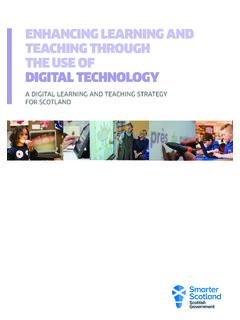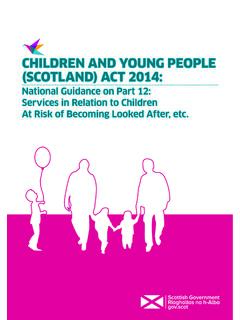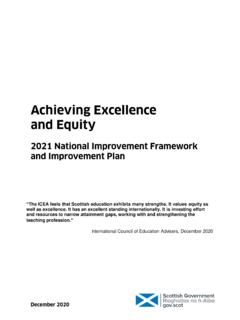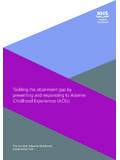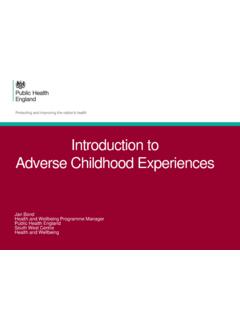Transcription of What have ACEs got to do with Justice? ADVERSITIES
1 UNDERSTANDING childhood ADVERSITY, RESILIENCE AND CRIME JUSTICE ANALYTICAL SERVICESPOINTS FOR REFLECTION10 most commonly measured Adverse childhood Experiences ( aces )The evidence does not prove causality. Not all children who experience multiple aces become victims or perpetrators of violence in adulthood, but they are statistically more likely to than people with no is predictable is also preventable.(Dr R. Anda)How can a harsh childhood lead to criminal behaviour? aces theory is consistent with the-ories of crime which have proven links between childhood factors and adulthood criminality and vic-timisation ( Agnew, 1985; Far-rington et al, 2006) Prolonged exposure to stress in childhood disrupts healthy brain development.
2 This can manifest as emotional and conduct problems in childhood , and risk-taking and criminal behaviours in adulthood. (Levenson et al, 2016) The more aces someone experiences the more detrimental the effect on their well-being (known as a graded dose-response ). (Centers for Disease Control and Prevention, 2015) aces have been linked to many criminogenic risks ( factors that in-crease risk of offending) including substance and alcohol abuse, depri-vation, poor educational attain-ment, and mental health problems. (Centers for Disease Control and Prevention, 2015)Most of the recognised aces (and other ADVERSITIES ) impact on the Justice and adults with experience of aces may come into contact with the criminal justice system - both as victims or witnesses and perpetrators of crime.
3 They may also interact with the civil justice family law system. The justice system therefore has a key role in preventing and, in particular, mitigating the impact of aces . What have aces got to do with Justice? Everything. This paper sets out a summary of the evidence on the links between childhood adversity and victimisation and criminality in adulthood. It makes a strong case for preventing crime by targeting those most at risk of experiencing adverse childhoods, and supporting people in the Justice System whose lives have been affected by adverse childhood experiences ( aces ) in order to reduce reoffending and prevent intergenerational crime and victim-isation.
4 It argues that this will require a coordinated and collaborative effort across consistently shows a strong association between aces and crime. People who experience multiple aces are more likely to engage in risk taking behaviours which are harmful to health and significantly for Justice some-times associated with criminal be-haviour. The Welsh aces Study (Public Health Wales NHS Trust, 2015) report-ed that compared with people with no aces , those with 4+ aces were: 14 times more likely to be a victim of violence in the last 12 months 15 times more likely to be a perpetrator of violence in the last 12 months 20 times more likely to have been incarcerated in their lives1 Preventing aces could provide a significant opportunity to reduce crime in Scotland.
5 Some studies have estimated that preventing aces could halve violence perpetration and in-carceration. (Bellis et al., 2014) Mental IllnessDomesticviolenceParental SeparationSubstance abuse Incarcerated relativeABUSEHOUSEHOLD ADVERSITIESP hysicalEmotionalSexualPhysicalVerbalNEGL ECTUNDERSTANDING childhood ADVERSITY, RESILIENCE AND CRIME JUSTICE ANALYTICAL SERVICESPOINTS FOR REFLECTIONP eople who experience multiple aces are more likely to be a victim of violence in adulthood than people who have no shows that people who are abused as children are more likely to be abused as an adult. As ACE scores increase, so too does adult sexual victimisation (Ports et al, 2016).
6 People who experience child abuse or witness domestic violence in childhood are more likely to be abused by a partner in adulthood than those who did not experience abuse/witness violence, particularly women. (CSEW, 2017) These studies point to the importance of understanding the role of childhood maltreatment in preventing and addressing victimisation in adulthood. People who offend are more likely to experience traumatic childhoods than the general studies report a higher incidence of aces in various offending groups (Leitch, 2017). Whilst equivalent research does not exist in the UK, prison surveys in the UK and in Scotland report high rates of childhood abuse, family violence, experience of being in care and school exclusion in people in prison.
7 (MOJ, 2012; SPS, 2015)Having a convicted family member and being excluded from school have been reported as risk factors for reoffending in adulthood. (MOJ, 2012) Many childhood ADVERSITIES , including those not included in the standard aces framework, tend to co-exist which makes it hard to identify which risk factors best predict criminality - some risk factors may be the result of early childhood trauma neurological deficits. However, some aces research has drawn links between specific aces ( child sexual abuse) and specific types of crime ( sex offending). Further research is needed to understand the causal mechanisms between childhood adversity/trauma and different types of criminality and victimisation in prisoner survey respondents reported that they had been physical-ly abused in their home as a child61%Adult prisoner survey respondents had been bullied at school or some-where else56%Young people in custody said they had been sworn at, humiliated, or put down by an adult in their homeDid you know that in do we know about the childhoods of justice users ?
8 Although Scottish data is limited, international evidence consistently shows high levels of childhood trauma and maltreatment in adult perpetrators and victims of certain crimes. Both criminality and victimisation can be intergenerational which points to the need to support families at the earliest stage possible. The list of 10 aces which is used in many aces studies does not cover all childhood factors associated with crime. There may therefore be merit in policy responses aimed at reducing crime to consider a wider range other childhood and childhood risk factors for CriminalityMuch less is known about the incidence and effect of childhood trauma on male offenders and victims.
9 Given that men are more likely to be a victim of violent crime and that the rate of conviction is higher for men, further research is violence(bullying perpetration)Poor school attainmentCommunity violenceLow impulse controlLow intelligenceNeurological de citsBrain injuryParental SeparationDomestic violenceMental illnessSubstance abuseAlcohol abuseImprisonmentMaltreatment- Physical abuse- Verbal abuse- Sexual abuse- Physical neglect- Emotional neglectFAMILYCOMMUNITY / SCHOOLINDIVIDUALD isturbed attachmentPoor parental supervisionLack of family stability & warmthHarsh disciplineExperience of being in careBereavement / lossPoverty / Social DeprivationACEs Other risk factorsUNDERSTANDING childhood ADVERSITY.
10 RESILIENCE AND CRIME JUSTICE ANALYTICAL SERVICESThe single most common factor for children who develop resilience is at least one stable and committed relationship with a supportive parent, caregiver, or other adult (Harvard University Center on the Developing Child).POINTS FOR REFLECTIONLOW LEVELS OF POVERTY & SOCIAL DEPRIVATION Live in safe neighbourhoods with opportunities for positive activities Low neighbourhood economic deprivation Higher family socioeconomic cir-cumstancesResearch suggests that resilience is built at an individual, family and community level. Policy responses should target all three domains to be most is limited in some areas. There is a lack of aces population studies which examine resilience in the context of offending and/or victimisation.

